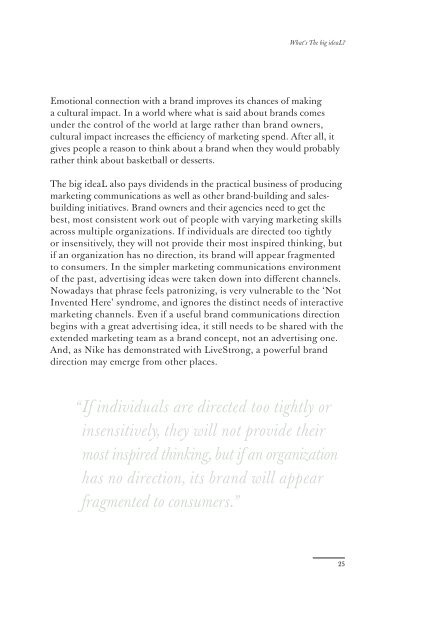The Red Papers: What's The big ideaLTM? Colin ... - Ogilvy & Mather
The Red Papers: What's The big ideaLTM? Colin ... - Ogilvy & Mather
The Red Papers: What's The big ideaLTM? Colin ... - Ogilvy & Mather
Create successful ePaper yourself
Turn your PDF publications into a flip-book with our unique Google optimized e-Paper software.
What’s <strong>The</strong> <strong>big</strong> ideaL?<br />
Emotional connection with a brand improves its chances of making<br />
a cultural impact. In a world where what is said about brands comes<br />
under the control of the world at large rather than brand owners,<br />
cultural impact increases the effi ciency of marketing spend. After all, it<br />
gives people a reason to think about a brand when they would probably<br />
rather think about basketball or desserts.<br />
<strong>The</strong> <strong>big</strong> ideaL also pays dividends in the practical business of producing<br />
marketing communications as well as other brand-building and salesbuilding<br />
initiatives. Brand owners and their agencies need to get the<br />
best, most consistent work out of people with varying marketing skills<br />
across multiple organizations. If individuals are directed too tightly<br />
or insensitively, they will not provide their most inspired thinking, but<br />
if an organization has no direction, its brand will appear fragmented<br />
to consumers. In the simpler marketing communications environment<br />
of the past, advertising ideas were taken down into diff erent channels.<br />
Nowadays that phrase feels patronizing, is very vulnerable to the ‘Not<br />
Invented Here’ syndrome, and ignores the distinct needs of interactive<br />
marketing channels. Even if a useful brand communications direction<br />
begins with a great advertising idea, it still needs to be shared with the<br />
extended marketing team as a brand concept, not an advertising one.<br />
And, as Nike has demonstrated with LiveStrong, a powerful brand<br />
direction may emerge from other places.<br />
“ If individuals are directed too tightly or<br />
insensitively, they will not provide their<br />
most inspired thinking, but if an organization<br />
has no direction, its brand will appear<br />
fragmented to consumers.”<br />
25


